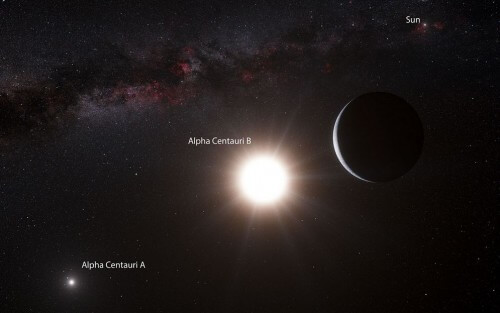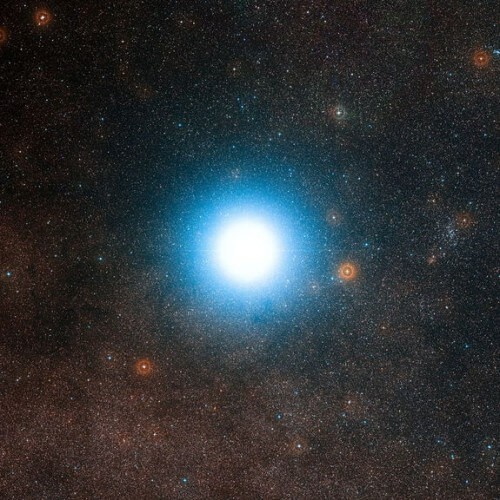However, with current technology it would take 19 thousand years or 600 generations to jump to this system which is 4.3 light years from Earth

Astronomers have discovered a fascinating planet that could be considered our closest neighbor. The planet orbits one of the stars in the binary system Alpha Centauri. This star system is the closest to us and is 4.3 light years away from us. The mass of the planet is similar to that of the Earth. It is also the lightest planet discovered near a Sun-like star.
While the planet is likely too hot to harbor life as we know it, this system may contain other potentially habitable planets, say researchers from the European Southern Observatory in La Silla, Chile.
The discovery is a big step towards discovering twins for the Earth in the immediate vicinity of the Sun" the team members wrote in the article.
"This is the first planet with a mass similar to that of the Earth that was discovered orbiting a star similar to the Sun. Its orbit is very close to the star and therefore it must be too hot to support life as we know it," says Stefan Audrey of the Geneva Observatory, co-author of the article published yesterday in Nature, and the team member who used the HARPS facility to find the planet. "However, it is possible that it is only one of the planets in a system that contains several. Other HARPS findings and a new Kepler finding clearly show that most of the minor planets are in such systems."
The planet named Alpha Centauri Bb orbits its star Alpha Centauri B once every 3.2 days at a distance of only about 6 million kilometers (for comparison, the Earth orbits the Sun in an orbit with a radius of 150 million kilometers), and much closer even than the orbit of the planet Mercury, So it is most likely covered in molten rock.
Many astronomers believed that the Alpha Centauri system would be a candidate to host Earth-sized worlds. In 2008, a team of astronomers ran a computer simulation of the first 200 million years of the system and in all probability, despite the introduction of different parameters, the result was that many small planets formed around the star. In any case, at least one planet reached the size of Earth, and in many cases these planets fell within the planet's habitable zone.
However, actual searches for planets in the Alpha Centauri system have so far come up empty-handed. "Our observations lasted over four years, and thanks to the HARPS instrument, we discovered a tiny, but distinct signal for the existence of a planet orbiting Alpha Centauri B every 3.2 days," says Javier Dumosque of the Geneva Observatory and the Center for Astrophysics at the University of Porto in Portugal and the lead researcher of the paper. "This is an outstanding discovery and it pushes our technique to the limits."
The detection method is known as radial velocity (the movement of the sun follows the tiny pull of the planet that surrounds it). The small mass of Alpha-Centauri B and its close distance to us, combined with a telescope with a 3.6 meter key, made the discovery of the small planet possible. And of course, the efforts of the astronomers. The effect is so small, because it causes the star to move back and forth at a speed of 1.8 km/h. The team says this is the most accuracy achieved using this method.
Alpha Centauri is one of the brightest stars in the southern sky and is actually a triple star - a system containing two stars similar to the Sun orbiting each other closely - called Alpha Centauri A and B, and a red and pale distant star, known as Proxima Centauri. Alpha Centauri B is very similar to the Sun but a little smaller and less bright. Alpha Centauri A's orbit around B is hundreds of times farther than the planet's orbit, but it will appear as a very bright object in the planet's sky.

The first planet orbiting a sun-like star was discovered by the same team in 1995 and now 843 exoplanets are registered, including Alpha Centauri Bb. Most of them are much larger than Earth and many of them are as large as Jupiter. The closest planet so far is Epsilon Eridani b, 10.4 light years away.
As for the obvious question, how long will it take a spacecraft from Earth to reach the Alpha Centauri group? If the current technology is used, in the slowest way of space propulsion - ion propulsion, it will take a spacecraft 81 thousand years to get there. Using the technology of one of the fastest spacecraft - Helios 2, and traveling at a constant speed of 240 thousand km/h will shorten the journey time over 4.3 light years to 19 thousand years or about 600 generations.

15 תגובות
The Latin letter c from the ancient Roman period is read by some as K and by others as che, therefore Caesarea is called Caesarea by Italians and Caesarea by Israelis just as in Italian the word Caesar is called Cesare Chezere in auditory writing and therefore there is no mistake in reading the system as Alpha Centauri or Centauri, because it really depends on the geography.
There is no certainty about the pronunciation of the letter in ancient times. A real living mystery.
In Hebrew you can write Turkey, Turkey, Turkey. Neither this, nor the second, nor the third are considered misspellings, even though the pronunciation of the word sounds the same.
Thanks
Views
Regarding NASA's distortion preventer - here is the article by Dr. Harold White from the Jet Propulsion Laboratory: http://goo.gl/fvWhA
It seems to me that Gilad is right, the system is named after a centaur from Greek mythology, therefore Alpha Centauri, and not as the Americans pronounce it, Centauri.
Probably the mistake is in English and not in Hebrew...
I think Avi Blizovsky is right. The correct name is really Alpha *k*ntauri. It derives from the name of the constellation 'Centaur' where the star is located. The meaning is the mythological creature that is half horse and half man. The original name in Greek used to have a kof at the beginning, so that in fact 'centauri' is the distorted form of the name, as it used to be in English.
I can't find what the same technology is that drove the Helios 2 to the record-breaking speed, beyond the chemical launcher called, by the way, Centaur.
Can someone please help me?
1. Already in the fifties, NASA had the "Orion" project to design a spacecraft that could reach 8-10% of the speed of light, by nuclear propulsion. At a speed of 5% of the speed of light (1/20) it would take such a spacecraft 87.34 years to reach Alpha Centauri. (4.367 * 20). and at a speed of 10% 44 years. It is a shame that since the fifties there has been no real progress in research in this field.
See:
http://en.wikipedia.org/wiki/Project_Orion_(nuclear_propulsion)
2. Regarding the "warp drive" that Avi Cohen brought here: the discussion at the moment is entirely theoretical. There are several intriguing theoretical models, the most promising of which is the "Alcubierre drive" by Miguel Alcubierre, who proposes a mathematical model of the contraction of space and time in front of the spacecraft, which will expand the space in time behind it to create a bubble that will move the spacecraft at a speed higher than the speed of light without violating the special theory of relativity.
The main problem is that the model requires a negative mass, which as far as we know does not exist. (only in theory).
See:
http://en.wikipedia.org/wiki/Alcubierre_drive
http://en.wikipedia.org/wiki/Negative_mass
Wow what a discovery I am one who researches about the discoveries of planets
Today there are 847 planets to discover the nearest planet was 14 light years away
Now it is 4.33 light years, what a discovery!!!!!!!!!!
And as for Epsilon, which is 10 light years away, according to what I understand, the star is not definitively confirmed
As in Galiza 581, where also two stars are not confirmed and 4 are, and the distance is 20.2 light years!
Alpha Cantori
This in English consists of two English words!
What a discovery!!! did me good!!
The correct name is Alpha Centauri in Hebrew as well
I remember this name from other books I read in Hebrew from 40 years ago and more
Apparently someone made a mistake in the translation a long time ago and since then the name has become centauri
To my father, thank you very much for the nice articles
Good Day
To Avi Cohen
By chance I'm still awake, I promise to check again in depth, because I read in Calcalist and it turns out that they cite a specific NASA competition. I will search maybe there is a site for this competition. But not anymore now. If you have read the article about the virus and the story of the apparent halt to warming, you will understand why I am sensitive to scientific accuracy on other sites.
Thanks anyway
Avi Blizovsky, I didn't come with claims, I just thought that Calcalist was a serious newspaper, and I wanted to know more about it...
Thanks for the effort anyway.
I checked and indeed they say centauri in English. I have also heard in the past that they say centauri in Hebrew and I was quite surprised even then...
If you fly non-linearly, it takes seconds.
In Hebrew, for decades I have known it as Alpha Centauri.
When I have unlimited manpower I will report every pips. Please make complaints to all parties in the field of science - science museums, universities, pharmaceutical companies, alternative energy companies, etc. who ignore the science website when it comes to advertising but attack it when it comes to public relations.
In any case, I looked for the news on the NASA website and on websites that I trust and did not find it, so it is probably a duck.
Don't you say Alpha Centauri and not Alpha Centauri in English?
Why is there no report on the website about the "space distortion" engine that they started working on and reported in Calcalist?
http://www.calcalist.co.il/internet/articles/0,7340,L-3583121,00.html?dcRef=ynet